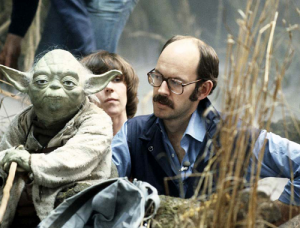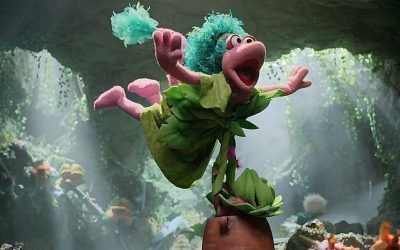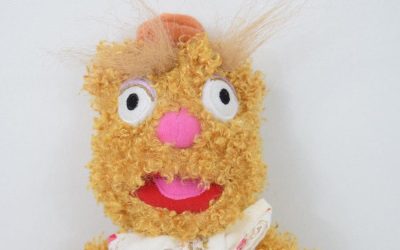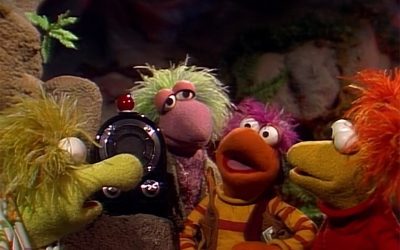Part 1: The Muppet Show and The Muppet Movie
Part 2: Fraggle Rock, The Dark Crystal, and Star Wars
Part 3: More Fraggles, Little Muppet Monsters, and No Strings USA
Audio version
When last we left off, Muppeteer Kathy Mullen was entertaining us with stories about working with Jim Henson, her time on The Muppet Show and movies, and just what it takes to perform a silent eyepatch-wearing cat. And now we’re back with part 2 of our interview, as you’ll hear all about her work on The Empire Strikes Back, The Dark Crystal, and Fraggle Rock!
Take it away, Kathy! (And us.)
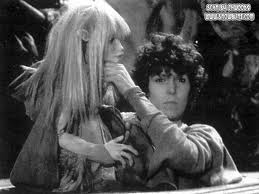 ToughPigs: So, you played Kira in The Dark Crystal. The puppetry was very different from the Muppet style.
ToughPigs: So, you played Kira in The Dark Crystal. The puppetry was very different from the Muppet style.
Kathy Mullen: Well, we did Yoda the year before. The reason Jim wanted to do Yoda was because he wanted the Dark Crystal characters to be “realistic”. In other words, not a fuzzy, bouncing Muppet. He wanted to give them the impression of real characters with real lives.
TP: So Jim consulted on the design for Yoda?
KM: It was designed by their person, [Stuart] Freeborn. Jim sent Wendy Miedner, now Froud, who was building Jen and Kira, to consult with them. It was R&D for Dark Crystal. Wendy worked with Stuart to try and get the puppet to work. Frank went back and forth too (it was just across the street) to help make Yoda into a working puppet. And he was, sort of. The eyes were done with a wad of cables that went down the back of Yoda’s neck and down through the body and out the bottom to this giant box where there were two joysticks to control the eyes. Wendy actually did that. Wendy worked the eyes, and I worked the right hand with Frank. I think I had the little smile and his ears in my control too. The puppet weighed a ton, like a Mack truck. The first thing we did was in [Yoda’s] little house. Now, there had been a lot of talk about how to do this. Yoda can’t bounce around like a Muppet, but when we saw the rushes of the first day’s shoot on the big screen, Frank went, “Holy crap, we’ve got to take it down by two-thirds.” So we did the whole first day over again.
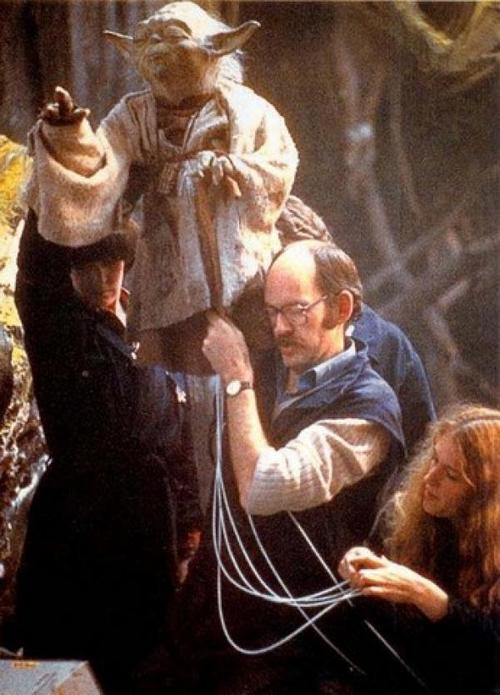 TP: Because you were moving too much?
TP: Because you were moving too much?
KM: Way too much. We were used to doing, “Woo hoo hoo!” all over the place, and Yoda was [makes a slow hand movement]. Here’s my funniest story about Yoda. It’s a puppeteer’s story. So, we’re lifting the X-Wing. It’s a close up, and Frank says, “So, what I want you to do is this.” [Puts two fingers out, slowly raises them] Right. So we get in there and I go [slowly raises hand]. “No no no no no, this.” [Slowly raises hand] Right. [Slowly raises hand again] “No no no no no!” [Slowly raises hand yet again] I swear to god it was the same every time, but to Frank’s eye it was not. When he was happy, we stopped.
Another funny story: It was a long shot. We’re in Dagoba. We’d been in there for days, in real water, real smoke. By the end of it, that place was a real swamp. It stank to high heaven. We were under the floor, and Frank is up through a hole in the floor with this horrendously heavy puppet. We’re in there, and Frank is in great pain. Irvin Kirshner, who was the director, is way over out of shot with the monitor, stroking his beard, and he yells, “Frank! Can you move about a foot to your left?” And we’re going “[screams]!” It was not funny at the time, but it’s very funny now. Kirshner finally twigs, “Oh… right. Never mind!”
TP: So, since you were the right hand, you’re the one with the Force.
KM: Clearly.
TP: You lifted an X-Wing!
KM: I did! I have the Force in my hands.
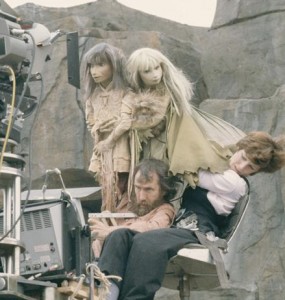 TP: So, did it get any easier to work on Dark Crystal having worked with Yoda?
TP: So, did it get any easier to work on Dark Crystal having worked with Yoda?
KM: Oh, it was crucial that we did that, I think we all knew the issues. I practiced in front of a monitor for a long time to try and get movements that were real. Jim, unfortunately, because he was producing, directing, everything-ing, didn’t have time to do the practicing that I did. He didn’t have time to work very hard on the grip of his puppet, I was working on my grip all the time to make sure I could get as much control as I could. I had videoed a lot of what I was working on, and I finally talked Jim into coming over and looking at what I’d been recording. He sat there and he said, “Okay, go ahead.” So I turned it on and he said, “How come your puppet works better than mine does?” I said, “Because you haven’t worked on your puppet, that’s why.” He went, “…I’m gonna go work on my puppet.” It wasn’t the fault of anybody, he just didn’t have the time to do it.
I’ll tell you what did happen, the first scenes we did with those two characters were with direct cable control heads, like Yoda. The heads were only this big [about the size of a grapefruit], I could barely get my hand in there. Jim couldn’t get his whole hand in there, but he had big hands. And then we’d have this wad of cables going down the back of the neck to do the eyes, the ears, a little smile, all on cable control just like Yoda. But Yoda was this big [about the size of a soccer ball], and he didn’t have to move much because he was Yoda. These puppets were impossible. I was in tears every night because I couldn’t get the puppet to move. We did one scene, and then there was the banquet scene that I wasn’t involved with, so I came back [to New York]. I was down at the Muppet Workshop one day, and I was chatting with [Muppet designer] Faz Fazakas, complaining about how difficult these puppets were because of the cables, and Faz says, “Well I told Jim he didn’t have to do that! I told him he could do it with a radio-controlled head!” I said, “What are you talking about?” “Jim, y’know, he doesn’t pay any attention. Here, let me show you.” He whips a little cloth off this Gelfling skull with eyes in it, and he had a little radio control box and [made the eyes move]. Radio control wasn’t anything new, we’d done it in larger contexts. My jaw dropped, because I could see that if we had that, it could save our lives. So I said, “Oh my god, what am I going to do?” I was terrified of calling Jim, so I called Frank, and I said, “Please please, I beg you, come and look at this.” He came and looked, and he talked to Jim, and Jim okayed the construction of the radio controlled gelfling heads. But by the time the heads were ready, Jim had done a whole scene without it, Jen sitting by the water. He redid that scene completely when he got the new head, because it was so stiff and awful. It was just one of those things, and I just happened to stumble upon it. I was scared enough of my own failure to say something. That wasn’t so easy for the newbie.
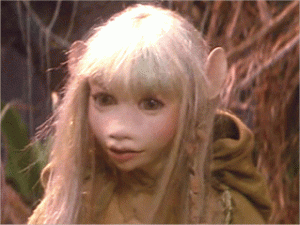 TP: So the vast majority of the movie is done with the radio-controlled heads?
TP: So the vast majority of the movie is done with the radio-controlled heads?
KM: Yes, the vast majority. Thank god.
TP: How did the movie on the big screen compare to what was in your head on the set?
KM: Oh, I was disappointed in myself. It was very hard to be objective back then, because you really have high hopes. I did, we all did. It was a huge project. It wasn’t a huge success, as you know. It became cult afterward. I think it was very disappointing for everybody. Some of it was wonderful, some of it worked very well. I know Jim after that said, “Never again will I do something like that. I’ll always have humans in there because it just didn’t read well enough.” But I never agreed with that. I think the problem was always the script. I think he started without a script, with a vague world idea. He didn’t build a script, he built a world. And then somebody figured out a script from the basic story idea.
TP: Visually and technically, it’s amazing.
KM: Yes, we had it all. What it was, was a very small moment in time. It was when Jim Henson had enough money, clout and time to develop the technology for this giant puppet show, but before computer animation came in and took over. It was a window of not very many years, really. I think it may be the only all-hand-puppet, fully-realized, live-action, puppet feature ever done. You’re never going to see that again… EVER! Not when it’s so much easier (and now cheaper) to do it with computer animation. We had everything but a story. Back then I felt sorry for myself, but later I just felt sorry that the movie didn’t fulfill the dream that Jim had.
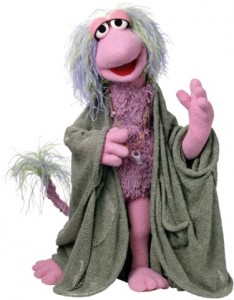 TP: Can you tell us a little about the development and the casting process for Fraggle Rock?
TP: Can you tell us a little about the development and the casting process for Fraggle Rock?
KM: The usual: Jim just chose who he thought should do it. Then he had us come in and improv and play around with the different characters and then he decided who he wanted to do which part.
TP: So, was Mokey already formed by then?
KM: The characters were basically formed. Michael and Jerry Juhl and Jocelyn [Stevenson] had spent a lot of time figuring out who they were, how they worked in this world, what they did… the basic idea of the show. So we knew who the characters were, but we had to put voices to them. That’s what the workshops were for. We played around and then Jim decided who was going to play each one. I actually thought I was going to play Red, but he flipped it around, which I thought was a very good choice in the end because Karen did a great job on Red.
TP: We always hear that story from Karen… that she wanted to play Mokey.
KM: I think we both thought we would be doing the opposite, and we were surprised when it went the other way. But I think Jim made the right choice, it just worked better that way.
TP: Were there any other puppeteers Jim was considering, or did he just know it would be these five performers?
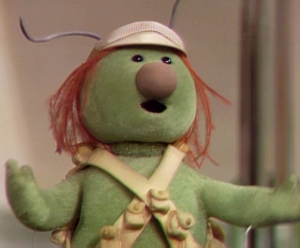 KM: I think he had picked the five performers, he just didn’t know what parts he wanted them to play. I’m casting for a No Strings project right now and I’m doing the same thing. I have a couple of parts and I have two great guys, I just don’t know which one I’m going to cast until I sit down with them and read, have them do some voices, and then we’ll decide.
KM: I think he had picked the five performers, he just didn’t know what parts he wanted them to play. I’m casting for a No Strings project right now and I’m doing the same thing. I have a couple of parts and I have two great guys, I just don’t know which one I’m going to cast until I sit down with them and read, have them do some voices, and then we’ll decide.
TP: You also played Cotterpin. Was this another one where someone just chose you to play the character?
KM: I’m not sure who decided I should do it, but Jerry Juhl (head writer) asked me. I don’t know what their process was, I was just asked to come up with a voice. So I did.
TP: Was it rewarding as a performer to watch Cotterpin evolve over the series?
KM: I think what actually happened was that Mokey wasn’t that popular, so they wanted to give me something else that would work, and it was Cotterpin. And I think that it seemed to work well enough. And it was fun, I liked doing it.
TP: One of my favorite details about Mokey is how she’s very touchy-feely. She’s always touching the other characters or pulling them in for a hug. Was that something that you decided to do or was that the director?
 KM: No, that was probably me. In truth, I don’t really remember, but in general, with our characters, because we had different directors all the time, any character development stuff was coming from us or between us. Then the directors would come in, take what we were doing, and use it.
KM: No, that was probably me. In truth, I don’t really remember, but in general, with our characters, because we had different directors all the time, any character development stuff was coming from us or between us. Then the directors would come in, take what we were doing, and use it.
TP: So you guys definitely had a hand in some of the creative process.
KM: It’s the kind of hand where you just develop as you go. You’re thinking of things all the time. What do I do here, what do I do there? Sometimes you’re talking to the writer. It was very kind of organic, there was never any plan behind it. It just happened naturally. And it was always that way with the Muppets. Jim was not much of a performance director, he was a shot director. He knew his shots, he knew his visuals. But he never said to you, “Play it this way, play it that way” ever. Frank did when he directed, but Jim didn’t. He might say, “Make it funnier.” You know, the school of “faster, louder, and funnier” direction.
TP: There weren’t a lot of female characters in children’s television at that time. There were ones more like Smurfette, kind of one-dimensional. Was that something that you were thinking about as far as girls watching the show at home?
KM: I wasn’t particularly. I think Michael and those guys were. For me, it was about making a character that had a certain reality to it within this world. It’s just what I would want to see. I think that is what most performers do. The writers and the conceptualizers were thinking, “We need something for the girls.” I think performers are thinking, “This is what I’d like to see.”
Tune in later this week for our third and final portion of our interview with Kathy Mullen when you’ll hear her talk about Little Muppet Monsters, The Christmas Toy, The Wubbulous World of Dr. Seuss, and more Fraggle Rock!
Click here to use the Force on the ToughPigs forum!
by Joe Hennes – Joe@ToughPigs.com

